- 1. How to Pick the Right Winter Camping Tent
- 1.1. Single Wall Four-Season Tents
- 1.2. Double Wall Four-Season Tents
- 1.3. Pyramid Four-Season Tents
- 2. How to Keep Your Tent Warm when Camping in Winter
- 2.1. Pick the Right Spot
- 2.2. Insulate!
- 2.3. Is an Air Mattress Really a Good Idea?
- 2.4. Additional Tips for Tent Interior
- 3. Are We Going to Eat Something?
- 3.1. How Much Food Do You Need?
- 3.2. Best Foods to Bring For Winter Camping
- 3.3. Prepare Food in Advance
- 3.4. Keep Food from Freezing
- 4. Backpack, Gear, and Clothing for Winter Camping
- 4.1. How to Choose a Winter Camping Backpack
- 4.2. Gear for Winter Camping
- 4.3. What to Wear on a Winter Camping Trip
- 5. Okay, What's Next?
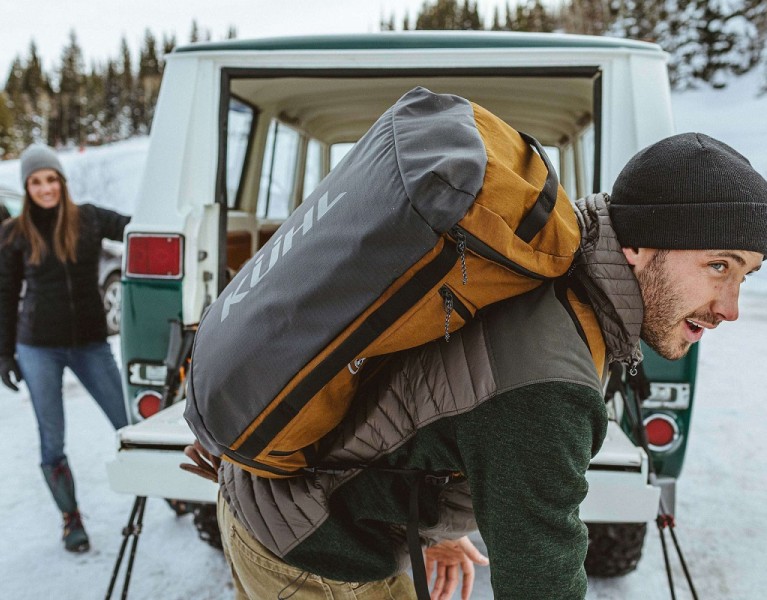
Winter Camping: An In-Depth Guide to the Basics of Camping in the Cold
Table of Contents [Show]
If you've never gone camping in the winter, now is just the right time! The temperature has taken a nosedive, but it doesn't mean you have to forget your enthusiasm for the outdoors and scrap your hiking/camping plans until spring.
With the right information and a good selection of gear, all outdoor enthusiasts can harvest the benefits of winter activities in the open. You don't need to be a pro to set up a winter camp! Whether you're an avid, experienced camper, or you're just beginning to explore the many benefits of getting in touch with nature, following a few simple steps is enough to get you on the right track.
Have you ever had an opportunity to make the first footprint in a snow-covered field? If not, it's about time! We have prepared a winter camping guide you need for getting out and having fun just like during the other three seasons of the year. Here you'll find everything from buying a good tent; insulating and maintaining warmth; preparing food; and choosing the best backpack, clothing, and the right gear. Check out our winter camping tips as well!
How to Pick the Right Winter Camping Tent
Before you start packing the gear, the first thing you'll need to think about is a sturdy winter tent. This tent needs to be able to withstand the conditions of a winter campsite. Remember that you'll rely heavily on this tent because, after all, it's your home for the next few days or weeks.
Make sure that the tent you choose for your winter tent camping is rated for four seasons. Tents that are rated for four seasons are sturdier and have multiple crossing poles that allow you to attach more guy-wires to better shore up your tent.
Four-season tents also seal up better than three-season tents. This is a real plus when those cold winds start howling through your campsite. Winter tents come in three different styles, each with pros and cons. We listed them out, so you can decide which would make a good fit for you and the cold weather conditions on your adventure.
Single Wall Four-Season Tents
These are specific winter camping tents. They're made from a single layer of specialized fabric, usually waterproof, made to withstand harsh weather conditions and excessive snowfall. The fabric keeps moisture out and breathes really well, venting the inside vapors like sweat and condensation.
These tents tend to be smaller, lighter, and easier to set up. However, they also have fewer features than double-wall tents. Single-wall four-season tents also tend to be a bit pricey and can turn into a sweatbox if the fabric is not breathable.
Double Wall Four-Season Tents
These two-layer tents are more commonly recognized by the added rainfly on their outside layer. This is great for an added front porch kind of space for extra storage and cooking in adverse conditions.
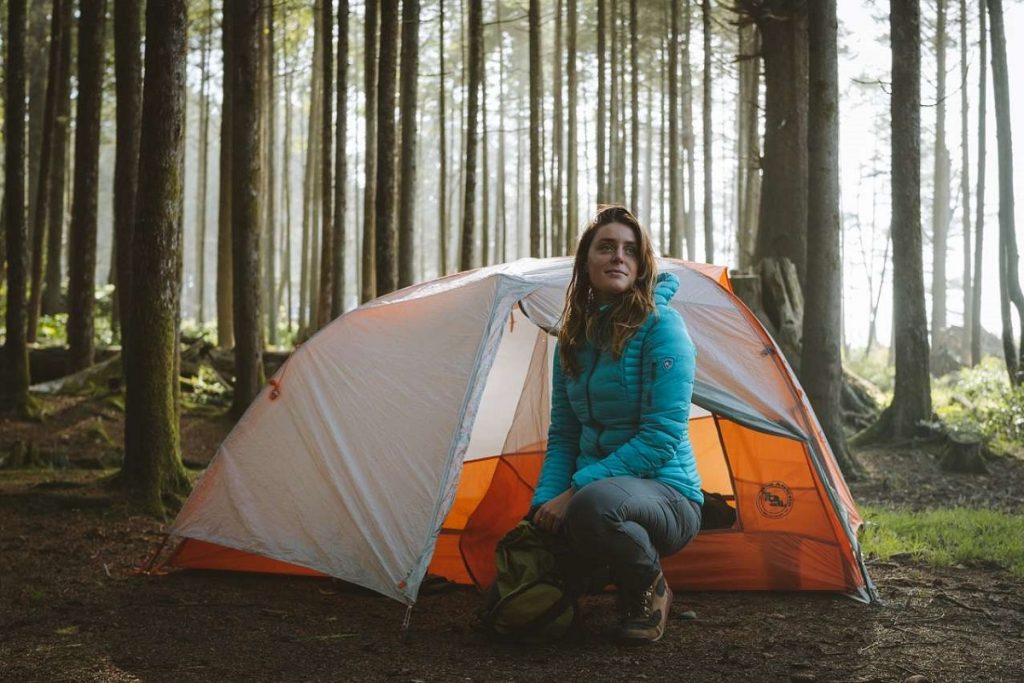
A rainfly is also an excellent tool for shedding any snowfall that piles up while you sleep. The inner layer is usually breathable and allows air to circulate, eliminating condensation.
Double-wall tents also have multiple crossing poles for added sturdiness. The downside of these tents is the added weight, as they tend to be a bit heavy. Also, setting them up requires a bit more work.
Pyramid Four-Season Tents
These are the tents that resemble an Indian tipi. They are tall and pointy which can be a bit more comfortable. On the other hand, additional material also adds weight. On the outside, the steeper angle tends to shed snow really well, but the extra height catches more wind which can make the tent unstable.
The big downside to a pyramid tent is that sometimes they're made without a floor. So, if you choose a pyramid tent, you're going to need extra ground cover to keep warm. Tents like these tend to be lighter both in weight and in cost.
No matter which tent you decide to pick, you'll need to know how to stay warm!
How to Keep Your Tent Warm when Camping in Winter
Pick the Right Spot
When looking for a place to set up your tent, follow one simple rule: Always look for high ground.
Take a quick survey of the area where you want to pitch your tent. Look for areas that tend to be flat and a bit higher than the surrounding area. You don't want to pitch your tent in a low spot where cold air can settle.
Also, look for any natural windbreaks. Pay attention to what direction the weather is coming from. Then select a spot that will give you the best protection from the elements.
Insulate!
You have the right tent, and the best spot, so now you can start insulating your tent from the cold ground. The more layers you can put between the floor of your tent and the frozen ground, the better your night is going to be.
It's a good idea to invest in a few mylar emergency blankets to use for added insulation under your tent floor. Also, consider using a sleeping pad, like a yoga mat. They are inexpensive and very dense, and they make for a good layer of insulation under the sleeping bag. Use two for an added layer of protection. After your first winter camping trip, you'll know what works best for you.
Is an Air Mattress Really a Good Idea?
Many people believe that sleeping on a simple air mattress will do the trick. In cold weather, this is not the best idea because the temperature of the air inside the mattress tends to match the temperature of the exterior. Your body heat is not enough to defeat the cold that's being pulled from the ground either.
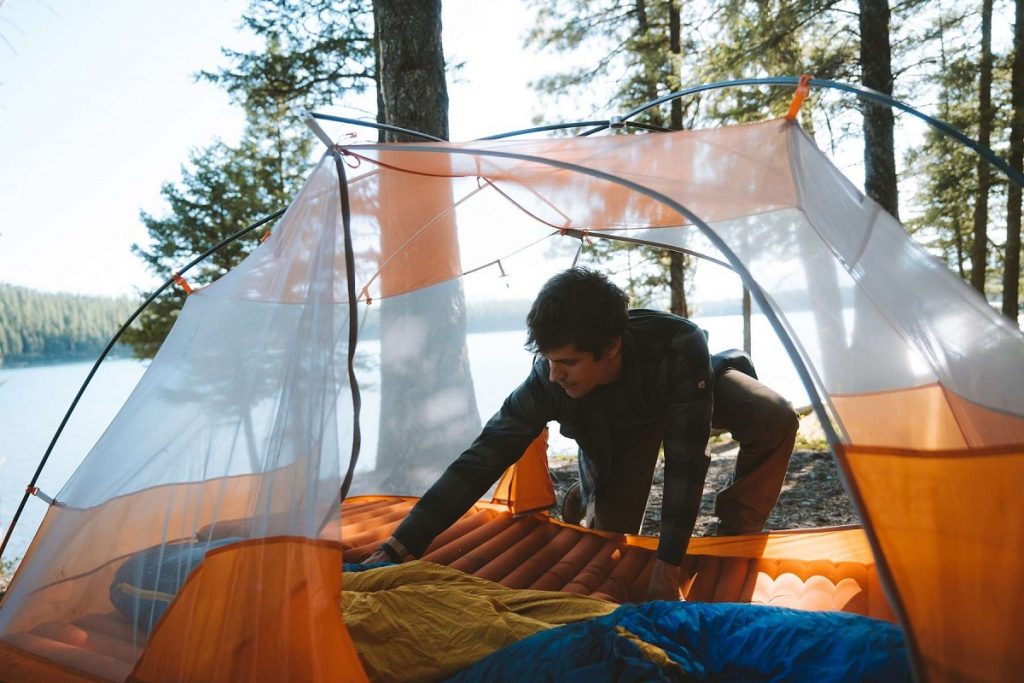
It's important to add additional layers, like a thermal blanket, a sleeping bag, and your base layer, between yourself and the air mattress. You can also get an insulated air mattress made specifically for the cold weather, or one of those with heaters that you can plug into your car. If you're bringing an air mattress, make sure it's adequate for winter.
Additional Tips for Tent Interior
Many avid winter campers turn to tent heaters for inside warmth. If you have one, they're especially useful for getting cozy inside the tent right before bedding down for the night.
It is not a good idea to fall asleep with one of these heaters on. Too much heat inside the tent can cause condensation to form on the ceiling and make the air stuffy and moist. The other downside of using a tent heater is that they tend to be a bit pricey, and they do require a lot of power to work.
This is why the best tip is to get enough insulation between you and the ground. A good tent with good insulation warms up pretty quickly and more importantly, conserves the heat for longer periods of time.
Once you have figured out how to pack your insulating material and sleeping mats, you'll want to spare no expense when it comes to your sleeping bag.
Make sure your chosen bag is rated for the temperature that you will be camping in. Mummy-style bags are among the best choices for camping in winter conditions. You can also sleep with a hot water bottle for added warmth inside your bag. Don't forget to protect your head, hands, and feet to stay warm and preserve body heat.
For more tips on setting up your tent, check out The Snow Camping Challenge: Preparing for Winter in the Backcountry.
Are We Going to Eat Something?
By now you've chosen the right tent, picked a good spot to set it up, insulated your tent, and made a good sleeping system. Learning how to prepare food is the next step in getting ready for an epic winter camping trip.
Preparing meals when camping can be the highlight of your day. Food just tastes better after a whole day hiking to the perfect campsite. Especially in winter, when your body works twice as hard to keep you warm while you're being physically active in the cold weather.
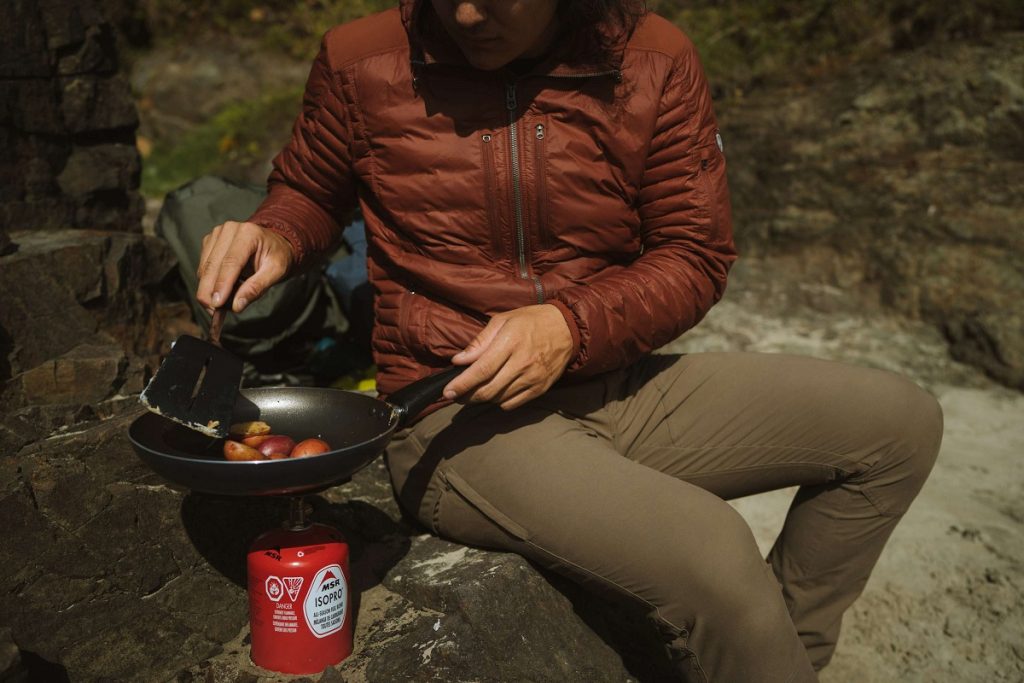
Remember how we discussed all the little nuances of tents for the winter? It's the same when it comes to preparing the food for winter camping. However, with careful preparation, there is no reason why you can't have a delicious meal at the end of a long backpacking day.
While the internet is chocked full of information on this subject, let's start with some basics. Here are the whats and hows of packing and preparing food for your next winter camping trip.
How Much Food Do You Need?
When you pack up all that gear and then backpack everything to the perfect campsite, you burn calories. And in winter when the temperature drops, you burn even more. Due to this significant increase, you'll need to boost your caloric intake - so, how many calories does a person need per day when winter camping?
According to Pack Your Tent, you should plan on at least 4000 calories per person per day. This breaks down to 2-2.5 pounds of food per person per day. Keep this in mind, the more activities you do during the day, the more food you will need. It's much better to bring back unused food as opposed to not having enough.
Best Foods to Bring For Winter Camping
The first thing to consider in the beginning is the added weight of your food supplies.
One of the best tips in food planning for winter camping is to avoid anything that contains a lot of water because the water adds weight. Fruits, vegetables, and eggs contain water and tend to freeze, adding weight for you to carry.
However, there is some fresh food that you can bring along without worrying about whether it'll be heavy or freeze in the colder conditions. By fresh food, we mean the food that is non-dehydrated and wasn't freeze-dried. For example, you can bring brownies, crackers, cheese, and dried meats such as salami and pepperoni.
Most of the experienced campers already know that dehydrated and freeze-dried foods are the best options to bring along on a camping trip. Don't get confused between freeze-dried foods and dehydrated foods. The freeze-dried food is quickly frozen and then the water is removed by a vacuum process, while dehydrated foods are heated to remove the water.
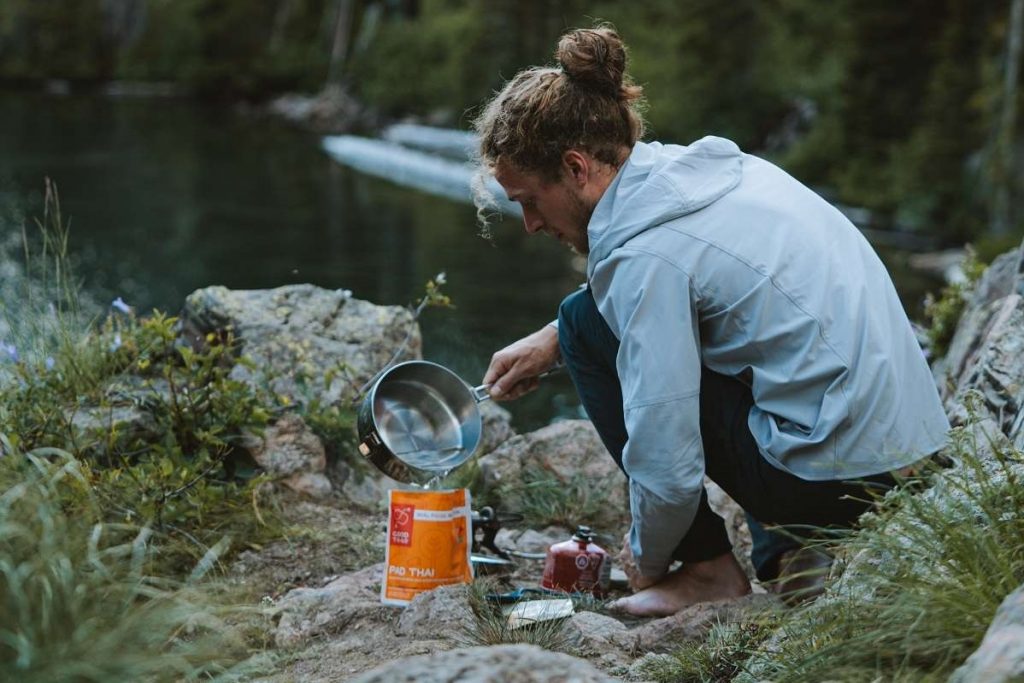
Dehydrated food lasts longer and doesn't add quite as much weight to your finished pack.
Many of your favorite foods can be processed in a food dehydrator before you leave. Since the price of a food dehydrator has fallen drastically since they were first introduced, this may be the most economical way to prepare most of your winter camping food. If you don't want to do it by yourself, you can buy some of the top-quality hiking/camping/backpacking foods online. Vegetarian and gluten-free options are also available.
Freeze-dried foods are more nutritious and once you add some boiling water, you have an excellent meal ready to eat. Freeze-dried foods of all sorts are also available online and at your local camping outfitter. They may be a bit pricey, but well worth it when you sit down after a cold day of trudging through the snow!
Prepare Food in Advance
Before you head out to that campsite, you can do yourself a favor by preparing some things ahead of time. Simply taking the time to do things (like getting the crackers out of the box and repacking them in baggies) saves time and space when heading out.
Another thing to consider is planning each meal in advance, so there is no room for confusion on the trip. It's easier to put a meal together after a long, cold day if everything is already planned out. Also, take the time to label everything as this will make your life a lot easier. Make those labels large enough to see in the dark!
An easy prep item is sandwiches. You can make several sandwiches before the trip, and pack them in sandwich bags. Count the number of companions, ask around for their favorite ingredients and make sandwiches! Passing them along to their prospective eaters will save you lots of nerves, time, and packing space.
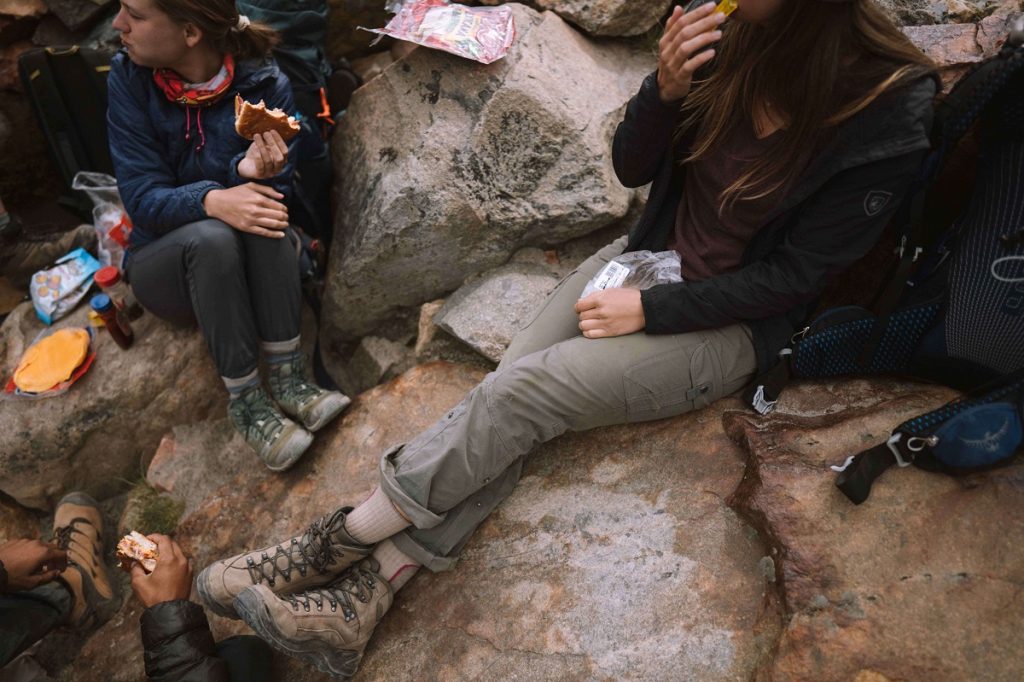
Pancakes are always a safe choice as they seem to be everyone's favorite food on a camping trip. They're easy to make, delicious to eat, and very versatile as everyone can eat them with what they like. Another plus is that there is an excellent way to prep a good pancake recipe beforehand. Just pack up some pancake mix that only requires adding water, put it in a gallon ziplock along with some freeze-dried berries, sugar, and chocolate chips. All you have to do is add water and voila! Food for everyone.
Don't forget the trail mix! You can make a trail mix in advance from very simple ingredients. Grab a ziplock baggie, and throw in some granola oats, raisins, and some peanuts (M&M's too!). Don't be afraid to experiment with different ingredients! Make several small packages of this so you can pass it around for your crew to munch on during the day.
Keep Food from Freezing
Yes, you can also bring along things like instant mashed potatoes, mac and cheese, frozen lasagna, ramen, and pretty much anything that can be easily transported in pouch form and brought to steaming delicious life with boiling water. Another important thing - if you plan to melt snow on the spot for prepping meals and drinking water, make sure to boil it first for filtration. This also means that you'll need to bring extra fuel.
Most of the foods and ideas listed here won't freeze because they have no added water. If you do take along things like energy bars, keep them close to your body, so they won't freeze.
Backpack, Gear, and Clothing for Winter Camping
Now that we have a warm and cozy place to sleep after a hot and delicious meal, it's time to talk about backpacks, gear, and of course, winter camping clothing.
Check out our complete winter camping checklist!
Winter camping trips require a good plan and even better preparation. If you don't have an appropriate backpack loaded with the gear you need, and if you're not wearing the right clothes for winter camping, we can all agree that you probably won't have a good time.
These three items are essentially the backbone of any successful camping trip - and even more so in winter! We've all once witnessed a camping getaway that started out with the greatest intentions, only to be cut short due to the fact that the campers didn't have the essential items to stand up to the task.
So, let's take a look at the essential items needed to make your winter camping expedition a huge success!
How to Choose a Winter Camping Backpack
Backpacks are everywhere. From simple book bags to elaborate mountain trekking packs, a backpack can come in many shapes and sizes. However, you need a pack that is designed to be comfortable for the body; strong and big enough to carry all (or most) of your gear; and durable enough to withstand what mother nature throws your way during the winter.
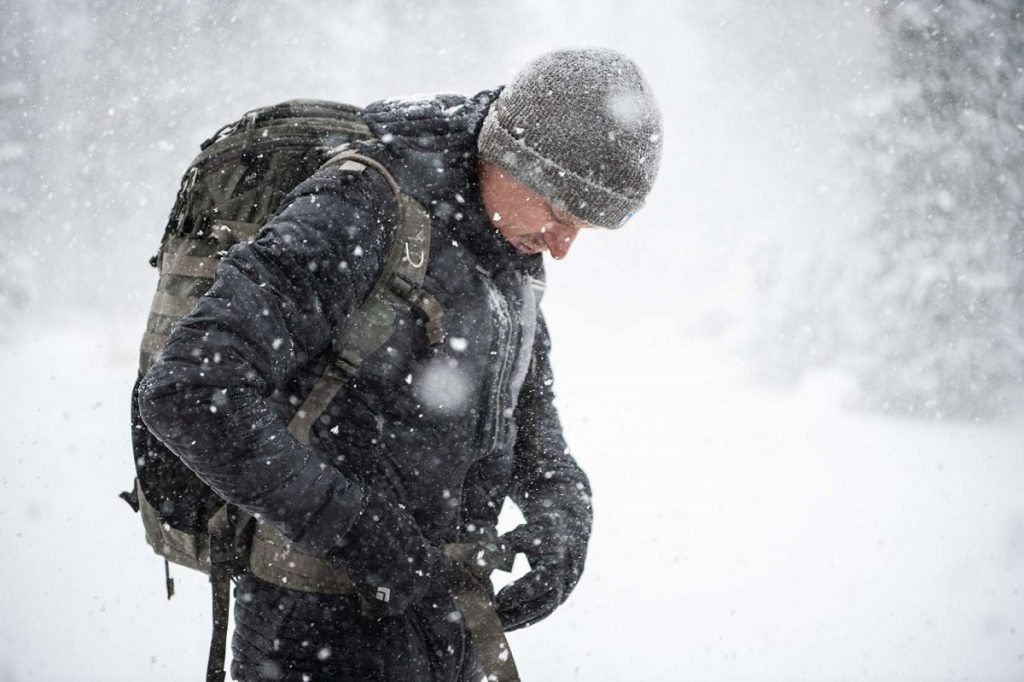
Before you try on a backpack, make a list of the gear you plan on carrying inside. This goes a long way in determining exactly what type of backpack you are going to need.
Some more experienced campers may be able to get by on just the bare minimum in their pack. Others plan on carrying everything but the kitchen sink! Think about how many days, weeks, or months you will be on this winter camping trip. Just a single overnighter, a weekend camp-away, a weeklong trek? When you put some thought into your gear list, everything else becomes easier.
Take your time and bring along that gear list with you if you need to buy a backpack. The salesperson at the outdoor shop, or the customer service if you're ordering online, can help you decide which is the best backpack for your trip. Some outdoor shops even have weights that you can add on the spot to simulate your gear load.
Gear for Winter Camping
Winter camping, like the other activities in the cool weather and snow, is all about staying warm and dry.
One of the best things you can do when taking on any winter outdoor activity is to invest in a quality pair of insulated boots for hiking. Sneakers or regular shoes will not hold up to the rigors of winter camping. A pair of moisture-wicking wool socks will keep your feet warm and comfortable underneath.
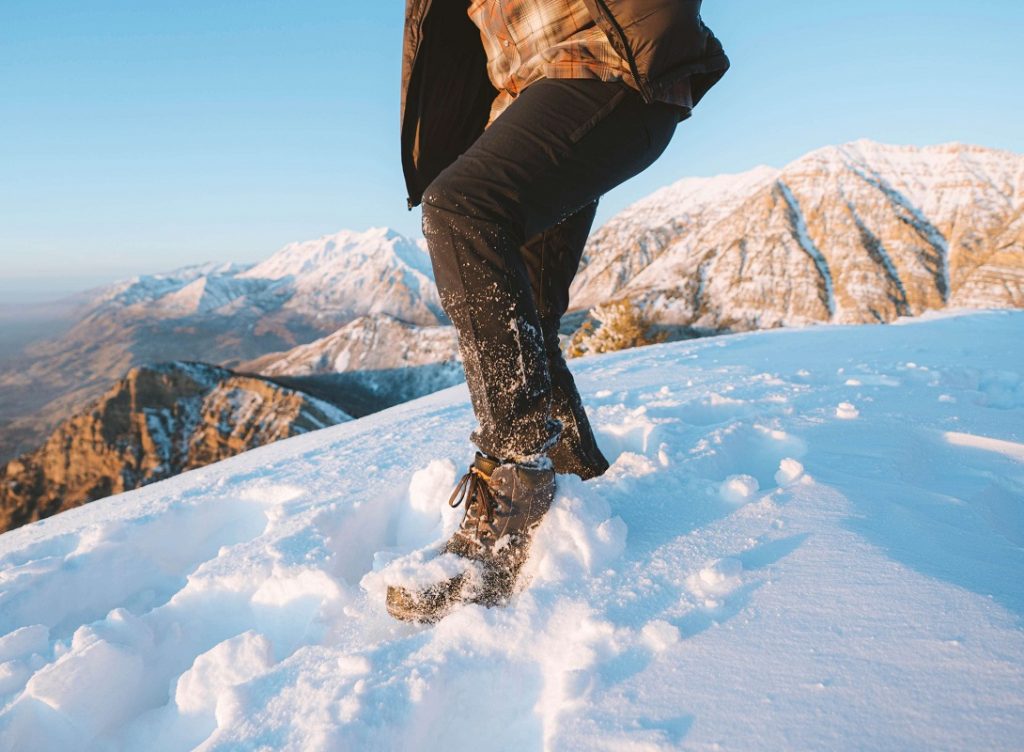
Someone from the group should bring a quality first-aid kit to every camping venture. It is much better to bring that kit home unopened than to need it, but not have it.
Also, invest in a quality camping lantern or two. It's rather nice to be able to light up your campsite when the sun goes down, even if you're planning to light a campfire.
We already discussed tents and sleeping bags. Be aware that these are two rather heavy and bulky items that you'll be carrying in your pack. As said, remember to get tents and sleeping bags that can withstand the weather conditions you are going to endure.
According to the type of food you plan to eat, invest in quality camping cookware. This cookware is maybe a bit heavy to carry, but well worth the effort when you are able to prepare a hot meal on a cold night. It depends on the food you've planned out, but in most cases, you don't need many items. If everyone brings just a couple of essentials - a pot or a pan, a camping mug, and a ladle - that will be enough.
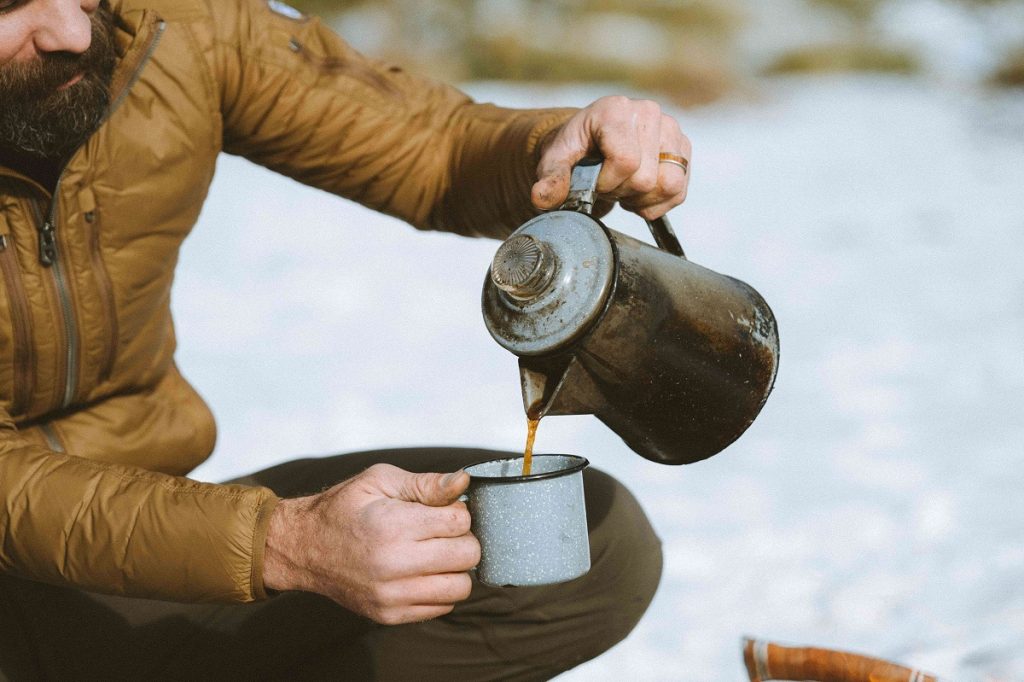
If you're not really sure how to read a map, someone else from the group should be good at it. Maps are essential gear items, and map reading is something every camper should be adept at. Make sure that someone has the most recent map of the area in which you will be camping. Knowing how to read a map or a compass may save your life - even though you usually use mobile apps and electronic devices on your trips.
Also, check out the important items campers often forget in 17 Winter Camping Items You’ll Only Forget Once.
What to Wear on a Winter Camping Trip
Many people bring bulkier and fluffier clothing to winter outdoor activities because they think it'll keep them warm. Once you're out there, this gets very frustrating as it limits the flexibility of your body, makes you sweat, and takes up space in the backpack.
That's why you shouldn't wear just anything for a winter camping adventure. Top-quality winter outdoor clothing is specially designed to be less bulky and provide the optimal warmth and freedom of movement when you're active in the outdoors.
Having good outdoor clothing for your winter camping trip is just as important as map reading skills. High-performing outdoor wear can keep you warm and dry in adverse weather. Some of the top winter pants even come with integrated RECCO® technology. RECCO reflectors can help rescuers find you if you get lost.
When looking for good winter hiking pants, think of the weather. Look for a durable and comfortable item that will protect your body from the elements like the Men's Resistor™ Series, Klash™ Pant, or W's Frost Softshell Pant.
Be sure to wear a top-quality base layer. A Merino wool base layer is an excellent start and also a comfortable clothing option inside the sleeping bag. As a material, Merino wool is gentle, odor-resistant, and has a natural ability to wick moisture away. For some people, it's the essential item of winter outdoor clothing because hiking and backpacking produce a lot of sweat. Sweating and wet clothes make your body temperature drop and in cold conditions, can even lead to hypothermia.
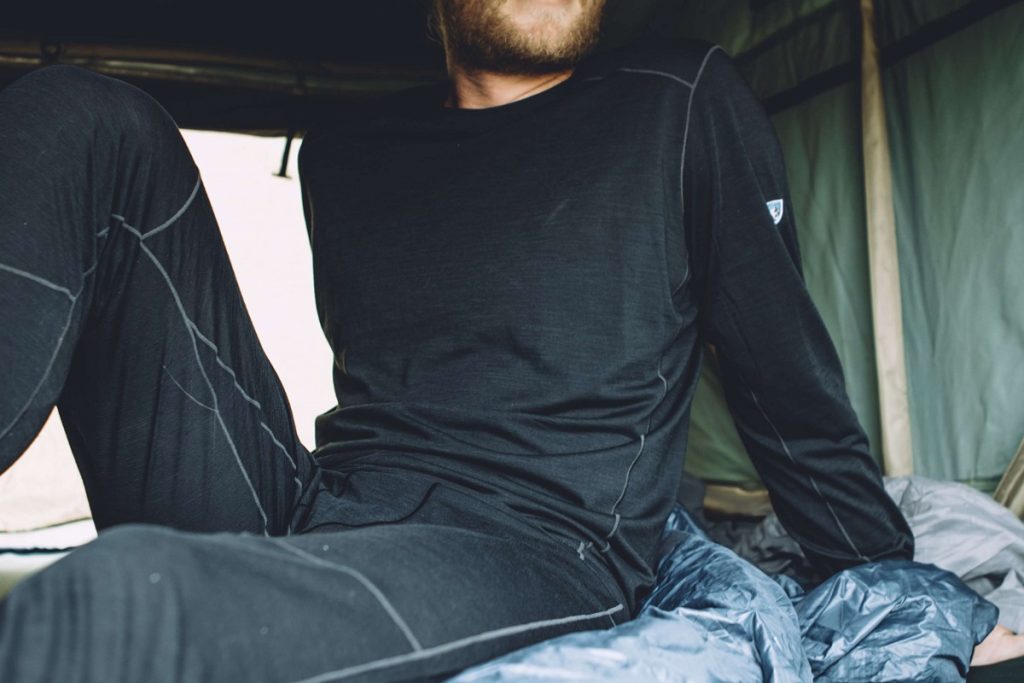
For the mid-layer, pick something with good insulation performance, like highly technical fleece or a Merino wool quarter-zip. This layer will conserve your body heat while protecting you from the cold air on the outside.
Your outer layer depends on the mid-layer and the weather conditions. A top-performing men's down jacket like M's Spyfire® Hoody with a body thermal mapping design or Arktik™ Down Parka is a good choice to keep your body warm in cold temperatures.
On top of everything, don't forget to protect your head, neck, hands, and feet. A warm hat and a neck gaiter can be lifesavers when you're winter camping. Good gloves, socks, and small hand and feet warmers should always be a part of your weekend camping gear as well.
Okay, What's Next?
We're sure you'll find all of these tips and tricks handy once you're out on the snowy trail with everything you need for a fantastic winter camping trip. Be sure to check out our online shop if you need to grab that one last thing before the trip!
Also, check out the posts below for some winter camping tips:
And some perfect winter camping sites:
All that's left is to get out there, and have fun!


